| Pages:
1
2 |
KonkreteRocketry
Hazard to Others
  
Posts: 165
Registered: 12-11-2012
Location: Dubai
Member Is Offline
Mood: No Mood
|
|
Any ways to make glutamic acid ? now i got some Nitric acid i made from NO2 and water.
|
|
|
Pyro
International Hazard
    
Posts: 1305
Registered: 6-4-2012
Location: Gent, Belgium
Member Is Offline
Mood: No Mood
|
|
determine the concentration of HNO3 by titrating it or by determining the m/V.and add it to the MSG. it should become glutamic acid and NaNO3 if i'm
not mistaken.
C5H8NO4Na+HNO3->C5H9NO4+NaNO3
169,111g C5H8NO4Na + 61,01g HNO3 * ->147,13g C5H9NO4 + 84,9947g NaNO3
* ( you will need to calculate how much of your stuff you need because it won't be 100%, more likely it's around 20-30% if you have made it from NO2
without distilling)
If you have accurate scales, weigh a 20ml measuring cylinder and write down the mass. then fill it with exactly 10ml of your HNO3 and weigh it again.
subtract the mass of the empty cylinder from the mass of the filled cylinder and divide by 10. that's how much 1ml weighs.
then compare to this table that I took from: ''Industrial nitrogen compounds and explosives''
will be added later, my pc won't open the PDF
Ok, My PC is still playing up, it's on the SM library, look it up yourself  it's
on one of the first few pages. it's
on one of the first few pages.
[Edited on 29-3-2013 by Pyro]
all above information is intellectual property of Pyro.  |
|
|
KonkreteRocketry
Hazard to Others
  
Posts: 165
Registered: 12-11-2012
Location: Dubai
Member Is Offline
Mood: No Mood
|
|
Quote: Originally posted by Pyro  | determine the concentration of HNO3 by titrating it or by determining the m/V.and add it to the MSG. it should become glutamic acid and NaNO3 if i'm
not mistaken.
C5H8NO4Na+HNO3->C5H9NO4+NaNO3
169,111g C5H8NO4Na + 61,01g HNO3 * ->147,13g C5H9NO4 + 84,9947g NaNO3
* ( you will need to calculate how much of your stuff you need because it won't be 100%, more likely it's around 20-30% if you have made it from NO2
without distilling)
If you have accurate scales, weigh a 20ml measuring cylinder and write down the mass. then fill it with exactly 10ml of your HNO3 and weigh it again.
subtract the mass of the empty cylinder from the mass of the filled cylinder and divide by 10. that's how much 1ml weighs.
then compare to this table that I took from: ''Industrial nitrogen compounds and explosives''
will be added later, my pc won't open the PDF
|
thx, however i have no idea my concentration of HNO3, i put N2O around 5 boubbles per second for like 10 min, to a h2o2 solution, i might have like a
3% thx any ways.
|
|
|
Pyro
International Hazard
    
Posts: 1305
Registered: 6-4-2012
Location: Gent, Belgium
Member Is Offline
Mood: No Mood
|
|
I just spent ages explaining it.
you need to measure the exact weight of 1 ml. like this:
"weigh a 20ml measuring cylinder and write down the mass. then fill it with exactly 10ml of your HNO3 and weigh it again. subtract the mass of the
empty cylinder from the mass of the filled cylinder and divide by 10'' or just titrate it.
then go to the SM library and look for the book ''industrial nitrogen compounds and explosives'' and scroll though the first few pages, there will be
a table with the relative masses of HNO3 and the corresponding concentration. my computer seems to hate this book, it won't open it and it won't go to
the SM library. but here's a different table:
http://www.handymath.com/cgi-bin/nitrictble2.cgi?submit=Entr...
get the number you find by weighing 10ml and dividing the weight by 10, for example you get: 1,23g/cm3 at 20*C
then you look at the top row of the table, move along until you reach 20*C. then move down until you find the number you have or the one closest to
it. with the numbers chose it is 38-39%
It really isn't that difficult!
all above information is intellectual property of Pyro.  |
|
|
BlackDragon2712
Hazard to Others
  
Posts: 124
Registered: 22-12-2012
Location: Everywhere
Member Is Offline
Mood: Sleepy
|
|
Not even a strong acid is necessary! I did it with a stoichiometrical ammount of glacial acetic acid and allowing the mixture to repose under -7C°.
glutamic acid will eventually precipitate out!

|
|
|
Agricola
Harmless

Posts: 42
Registered: 28-10-2013
Location: Brazil
Member Is Offline
Mood: No Mood
|
|
If you need glutamic acid in solution of course you can usually employ acidic solutions of MSG without isolating the acid first.
Some interesting stuff to do with glutamate found on the literature:
You can decarboxylate glutamate (Glu) to make gamma-aminobutyrate (GABA). Laval uses NBS (N-bromosuccinimide), NiCl2, and NaBH4. Camien uses an enzyme
preparation (to make that, see the paper's references; notice that E. coli can be used). Both authors claim a 68% yield.
You can nitrosate GABA or Glu to make lactones in 70 or 100% yield (according to NMR, isolated yield should be smaller) according to Gouesnard.
See the attached papers.
Attachment: camien1953.pdf (146kB)
This file has been downloaded 712 times
Attachment: gouesnard1989.pdf (1.7MB)
This file has been downloaded 938 times
Attachment: laval2003.pdf (66kB)
This file has been downloaded 646 times
|
|
|
Lion850
National Hazard
   
Posts: 514
Registered: 7-10-2019
Location: Australia
Member Is Offline
Mood: Great
|
|
Seems that MSG DOES make a complex with copper.
I purchased a bag of food flavouring that says it is 99% plus pure MSG. Cost was around AUD 3.50.
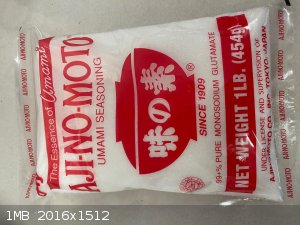
The plan was to react a solution of MSG with a solution of copper nitrate and see if there is a colour change, and if yes then try to extract the
salt. I was not sure which of these 2 reactions will happen (if at all):
Cu(NO3)2 + 2 C5H8NO4Na = Cu(C5H8NO4)2 + 2 NaNO3
or
Cu(NO3)2 + C5H8NO4Na = CuC5H7NO4 + NaNO3 + HNO3
and the stoichiometry is quite different between them. I decided to try and do the experiment with quite concentrated solutions, and if there is a
colour change but no ppt try to crystalize out something by gradual volume reduction (but this was not necessary).
- 60g msg was dissolved on 85g water, with slight heating this quickly gave a clear solution.
- 35g copper nitrate solution was dissolved into 45g water, giving a blue solution.
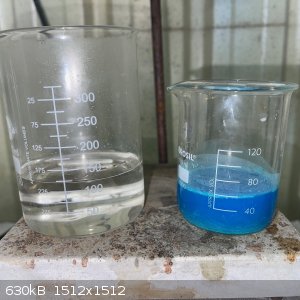
- The solutions were mixed and immediately turned very dark blue-purple. I'll try to post a video as a separate post.
- After a few minutes stirring a suspension formed.
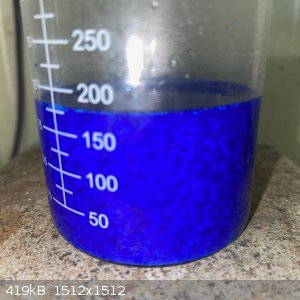
- After a few more minutes it became a firm jelly!
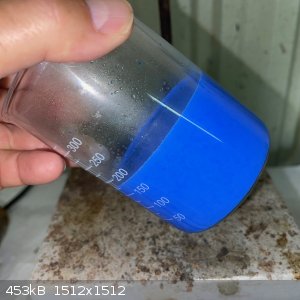
- I scooped out some and stirred it with excess methanol. This gave a fine light purple suspension which was filtered off and placed in the sun to
dry. Below shows this remainder, but with the iphone it looks much less purple than with the eye.
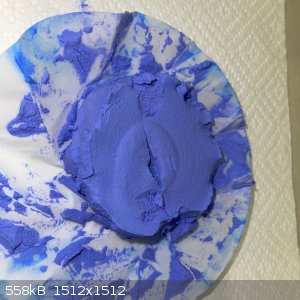
- I added excess water to the bulk and stirred it for an hour. This broke it up and it became a fine suspension.
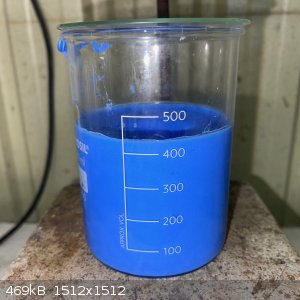
- This was then vacuum filtered. The wash water remained blue so I suspect it is slightly soluble in water.
- The remainder was dried on a steam bath for 3 hours. It was then bottled. The product is predominantly blue, but various shades. It may well be a
mix of a few things.
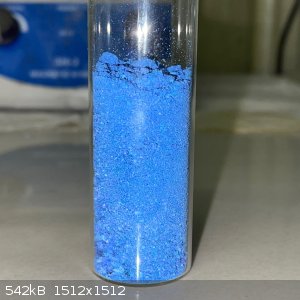
- I took a bit of the product and put it in a small crucible and on my hotplate at maximum heat which should be > 250C. It melted, bubbled a bit,
and I was left with a black solid substance.
- I wondered whether there was traces of copper in the charred remains and added 70% nitric acid. The acid bubbled a bit and released NO2. I don't
know if the release of NO2 confirms copper was present or whether there was another reaction.
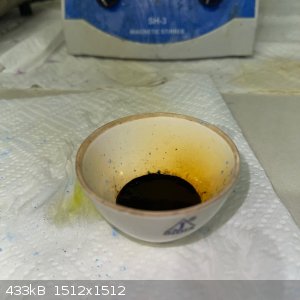
Cleaning up all the beakers and dishes was quite easy as the product dissolves readily in concentrated HCl.
I'll try a few more metal salts over the coming weeks.
|
|
|
Lion850
National Hazard
   
Posts: 514
Registered: 7-10-2019
Location: Australia
Member Is Offline
Mood: Great
|
|
This is a video showing the immediate color change when the copper nitrate solution was added to the mono sodium glutamate solution. I tried to post
it in the previous post but it did not work.
Attachment: 3.MOV (2.3MB)
This file has been downloaded 302 times
|
|
|
karlos³
International Hazard
    
Posts: 1520
Registered: 10-1-2011
Location: yes!
Member Is Offline
Mood: oxazolidinic 8)
|
|
Hey I used the same brand of MSG to make glutamic acid and then thalidomide from that!
|
|
|
Lion850
National Hazard
   
Posts: 514
Registered: 7-10-2019
Location: Australia
Member Is Offline
Mood: Great
|
|
Further to my initial post, the ppt that I stirred with methanol and the ppt that was stirred with water were both out on the bench for a week. The
methanol ppt now appears completely dry but the water ppt is still a tad tacky. The interesting observation is the colour difference between the 3
products as shown below:
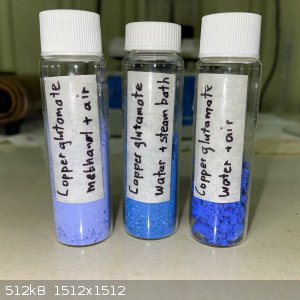 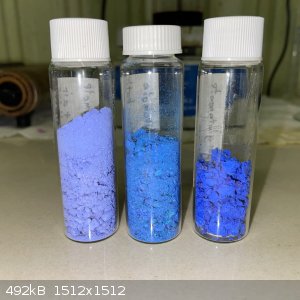
I can report that I also tried a double displacement reaction between MSG and chromium nitrate. Initially it seemed nothing happened, the solutionn
stayed dark without a suspension forming. After 24 hours I saw there was a red-purple color, and boiling down the solution gave a sticky mess with
this red-purple color. For now I did not manage to extract any dry product from it.
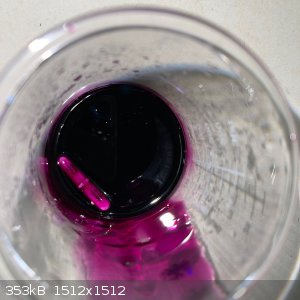
|
|
|
Boffis
International Hazard
    
Posts: 1836
Registered: 1-5-2011
Member Is Offline
Mood: No Mood
|
|
Maybe try triturating it with ethanol or ether this sometimes makes these viscous solutions crystallise.
|
|
|
macckone
International Hazard
    
Posts: 2159
Registered: 1-3-2013
Location: Over a mile high
Member Is Offline
Mood: Electrical
|
|
People blame MSG for chinese restaurant syndrome when it is more likely the fried rice contaminated with Bacillus cereus. Large batches of rice are
often left to cook and harden and that gives the bacteria a chance to grow. Then when they are cooked the bacteria die but they can leave behind
toxins. Most people can handle minute amounts fine but some people are sensitive. Since it normally isn't fatal, the reaction to contaminated rice
is not well studied below the levels that make people vomit.
|
|
|
Lion850
National Hazard
   
Posts: 514
Registered: 7-10-2019
Location: Australia
Member Is Offline
Mood: Great
|
|
I managed to get a lovely coloured salt from the chromium - msg reaction.
- 50g MSG was dissolved in 90g water, this easily dissolved into a clear solution, no heating required.
- 21g Cr(NO3)3.9H2O was dissolved in 30g water. This did need some heating to fully dissolve into a dark solution.
- Add the Cr solution to the MSG solution while stirring. It seemed that nothing happened and it was left overnight.
- Next day it was observed that the solution was now a deep mauve colour, but with no ppt.
- Steam down the solution from 170 to 70 ml and leave overnight.
- Next day - a sticky thick mess! Try to stir bits in warm methanol, DCM, and acetone but no effect. It neither dissolved nor broke up.
- Next day add water to 250ml mark and heated a bit to re-dissolve. Then add 250ml methanol and stirred for 30 minutes, this caused a mauve coloured
suspension to appear. Leave overnight.
- Next day: Filter. Copious amount of mauve coloured remainder, 300ml of mauve coloured filtrate. Leave remainder out on stacks of paper towel to dry.
- After 48 hours: Remainder now quite dry and much reduced in volume. Still a lovely dark mauve colour:
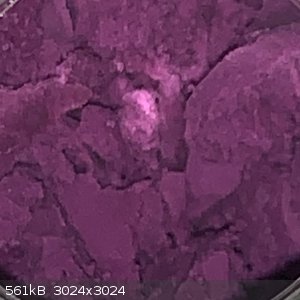
- Note there is no sign of any white bits in the product. So where did any excess MSG or any sodium nitrate (if any formed) go? If there was a
significant amount of a white product mixed in with the remainder one can usually see signs of it. Is it still in the filtrate, did the methanol
preferentially precipitated out only the mauve compound (which is what I was hoping and why I did not add a huge excess of methanol).
- Pour 100ml of the filtrate into a plate and leave to slowly evaporate, to see what appears. This is still ongoing.
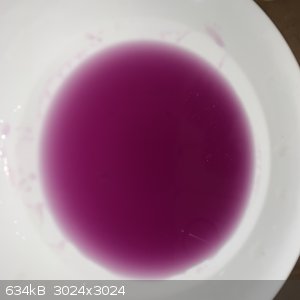
- 27g of mauve product bottled. Is it chromium glutamate? Is it a chromium sodium double salt? Is this an usual color for a chromium salt?
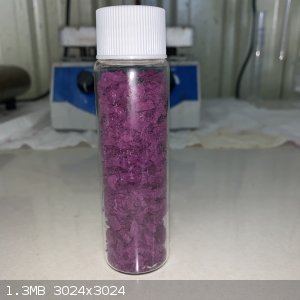 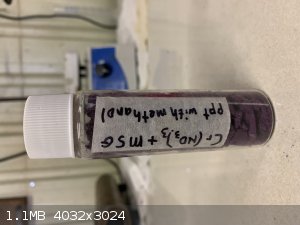
Any feedback as to what I made welcomed.
I still have cobalt, nickel, iron, and manganese to react with MSG over the next weeks, as time allows!
|
|
|
Lion850
National Hazard
   
Posts: 514
Registered: 7-10-2019
Location: Australia
Member Is Offline
Mood: Great
|
|
Cobalt:
- 35g MSG dissolved in 70g water
- 35g cobalt nitrate dissolved in 35g water
- The cobalt solution was poured into the MSG solution while stirring, this resulted in a very dark solution but no obvious suspension or ppt.
- Decant 100ml for test. Add 50ml methanol. This gave a pink, sticky suspension:
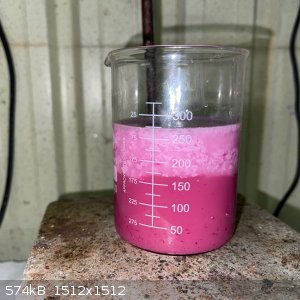
- The suspension re-dissolved when stirred. It stayed the same when heated to near-boiling.
- Add sample back into main beaker and stop for the night.
Next day:
- Transfer to large beaker, add water to make up to 500ml volume. Heat to near boil.
- Slowly start adding more methanol while stirring. A pink suspension started to form again.
- Add a total of 300ml methanol and stirred for 10 minutes. This resulted in a magenta coloured solution with lots of suspension swirling around (not
so easy to see the solids on the photo):
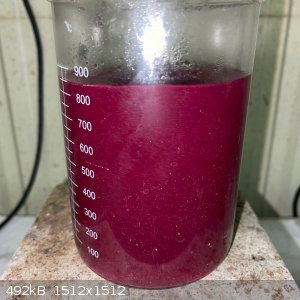
- Vacuum filter. The filtrate and remainder were both dark magenta coloured. The remainder was quite dry straight from the filter.
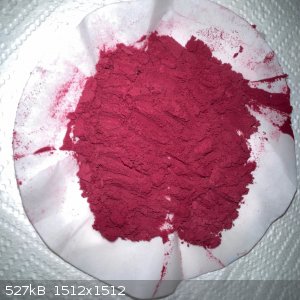
- Leave on bench to dry 36 hours.
- Result was 12.9g of a soft magenta coloured product:
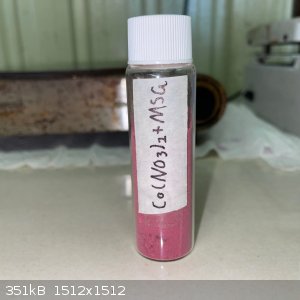
The product, which I assume is a cobalt glutamate complex, dissolved easily in concentrated hydrochloric acid giving a blue solution which turns
red-pink when water is added. If anyone has info on metal glutamates and can confirm the colours I get it will be appreciated. Iron will be next.
Something interesting happened when I cleaned a beaker that had a layer of the Chromium product described in an earlier post in this tread. I added
concentrated HCl but this did not dissolve the layer of "chromium glutamate". I then heated the beaker. This caused the layer to dissolve into a black
solution. But then copious amounts of white fumes started to appear. I took the beaker off the heat but even when it could be touched it was still
giving off a lot of white fumes with a slightly irritating taste. I had to leave the shed for a while until it cleared. What could this have been? To
me it looked just like the effect when one mixes ammonia with hydrochloric acid and get clouds of ammonium chloride. I did not see this when using HCl
to clean after making the copper, cobalt, or iron glutamates (but they all dissolved more readily in HCl).
|
|
|
Lion850
National Hazard
   
Posts: 514
Registered: 7-10-2019
Location: Australia
Member Is Offline
Mood: Great
|
|
Iron:
As often Iron yielded confusing results.
- 26g MSG dissolved in 300ml water, giving a clear solution.
- 20g Fe(NO3)3.9H2O dissolved in 75mm water, giving an orange-ish solution.
- Mix hot - the solution went dark, and there appeared to be some ppt but almost nothing.
- Add 300ml methanol. A brown-orange suspension formed. Stir 10 minutes.
- Vacuum filter. Filtering was slow as the brown remainder was very fine. The filtrate was wine red.
- The remainder when scratched off the filter paper was surprisingly dry:
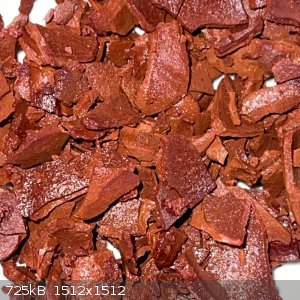
- Leave out on bench to dry.
- Next day: The product was seemed to have attracted moisture from the air and was now dark and wet:
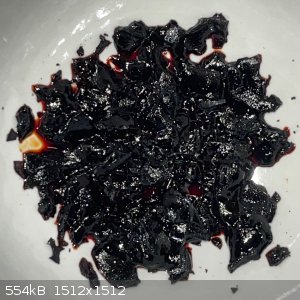
- In desiccator, vacuum over NaOH for 48 hours.
- Result was hard, dry black crystals:
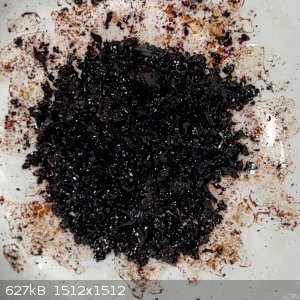
- 3.6g was recovered and bottled:
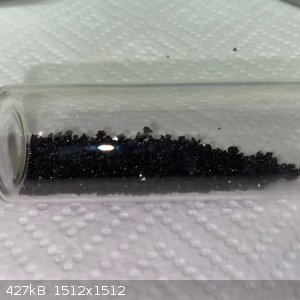
This was the first of the glutamate reactions that gave a product that was more difficult to filter out, and that seems hygroscopic. It dissolved in
concentrated HCl giving a green-yellow solution presumably of FeCl3; the wet brown remainder dissolving much easier in the acid than the dry black
remainder. But it is a iron glutamate complex or something else. Any ideas? What also surprised me is the fact that it was filtered out from the
solution that was at least 50% water quite "dry" but then became more wet on the bench. Was it dry in the solution because of the methanol in the
water, or because it was filtered when hot?
Next and probably the last of the MSG experiments will be nickel.
|
|
|
Triflic Acid
Hazard to Others
  
Posts: 486
Registered: 27-9-2020
Member Is Offline
Mood: Slowly Oxidizing into Oblivion
|
|
If you have some left over, maybe try this: http://www.sciencemadness.org/talk/viewthread.php?tid=157679
There wasn't a fire, we just had an uncontrolled rapid oxidation event at the power plant.
|
|
|
Lion850
National Hazard
   
Posts: 514
Registered: 7-10-2019
Location: Australia
Member Is Offline
Mood: Great
|
|
Triflic Acid thanks for the link but I think beyond my skills 
The final "MSG" salt I tried was nickel. But it was a failure. I added a solution of nickel nitrate to a solution of monosodium glutamate. There was
not apparent reaction. I left it overnight but it looked the same the next day: a dark green solution. At this point the total solution volume was
some 200ml. While stirring it I slowly added an equal amount of methanol. A suspension formed:
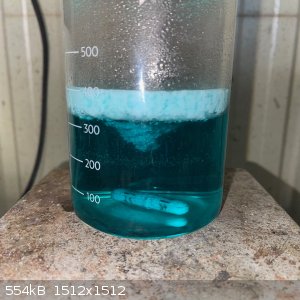
When soon condensed into a very sticky ball:
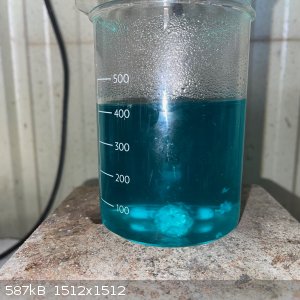
The sticky ball became like soft putty when the solution was heated but it did not break up. At this point I left the solution to sit overnight.
The next day the solution was clear again; the goop obviously dissolved again. I stopped the experiment at this point as I am now short on methanol. I
don't know whether the solids that appeared after adding methanol was a nickel glutamate salt or whether it was just the nickel nitrate that was
temporary kicked out of solution.
To finish this thread for now, here is a group photo.
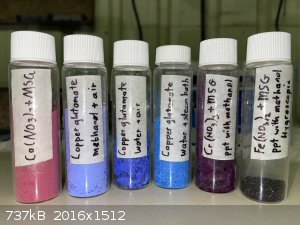
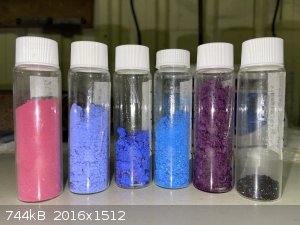
|
|
|
TmNhRhMgBrSe
Hazard to Others
  
Posts: 112
Registered: 4-7-2019
Member Is Offline
|
|
Because Lion850 didn't tryed Fe2+ so I tryed this. I used 5.5g MSG and 4.0g FeSO4 7H2O(2:1 mole ratio). I dissolved MSG and add FeSO4 7H2O solid. the
solution becomed deep brown(1st photo). And then I added isopropyl alcohol to try remove some water. solution becomed 2 layers(2nd photo). lower layer
like soy sauce(laugh). upper layer almost clear, have little brwon, maybe have little product? More isopropyl alcohol also didn't make solid
presipitate out, so I didn't tryed crystalise. 2nd time I used 3:1 mole ratio. this time the solution becomed lighter brown, didn't like last time so
deep. also this time the solution have solid presipitate out(3rd photo). If I use plastic spoon to scoop/ladle the solution the solution surface
becomed deeper colour. I think the reason is Fe2+ oxidised to Fe3+. Now I understand why Lion850 didn't tryed Fe2+.
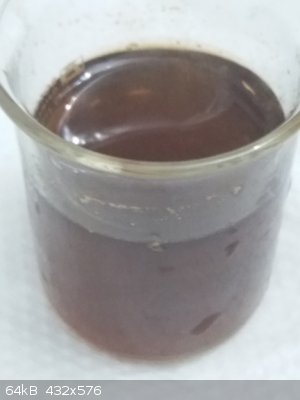 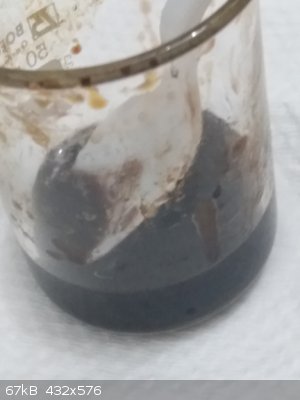 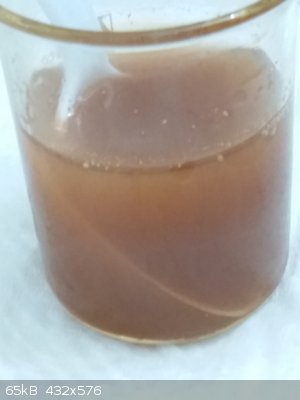
sorry for bad english
|
|
|
Tsjerk
International Hazard
    
Posts: 3022
Registered: 20-4-2005
Location: Netherlands
Member Is Offline
Mood: Mood
|
|
What color did the iron(II) solid have when you made it? Next time I think you better dissolve it before adding it I think.
|
|
|
TmNhRhMgBrSe
Hazard to Others
  
Posts: 112
Registered: 4-7-2019
Member Is Offline
|
|
@Tsjerk iron(II) solid? I don't understand this. My FeSO4 7H2O is green small granule, diametre about 1mm, but some granules because too old so
becomed brown/yellow.
sorry for bad english
|
|
|
Tsjerk
International Hazard
    
Posts: 3022
Registered: 20-4-2005
Location: Netherlands
Member Is Offline
Mood: Mood
|
|
Then I understand the brown color. My Fe(II) solutios are green.
|
|
|
| Pages:
1
2 |